Cloud computing is becoming a key element in service provision, allowing access to resources across internet transparently without the hassle of investing hardware resources nor maintaining or managing them. At present, sharing of media files with friends and families get admired worldwide. UPNA or DLNA are protocols designed to share content between devices within home network. It lacks the mechanism to share content outside the home domain and it doesn’t support advanced search capabilities. To alleviate the above problem, we propose Media Cloud, a middleware instantiated in set-top boxes to manage media transparently allowing uniform access to multimedia content belonging to different home. In addition, construction of cloud computing and security mechanism of material protection calculating method, namely, Global Authentication Register System (GARS), to reduce cloud material outflow risk.
Keywords |
| UPnp,DLNA,GARS,TTP |
INTRODUCTION |
| Cloud computing is a new paradigm that offers scalability, reliability, availability when accessing resources across
Internet. Moreover cloud computing is expected to abstract the details of the underlying infrastructure even when they
are complex. The term "cloud" is a metaphor for the Internet, the network over which different organizations join to
dynamically offer scalable resources. Media management is among the most outstanding aspects of cloud computing,
since the cloud makes possible to retain and share large amounts of digital media. Cloud computing might be a good
solution for processing content in distributed environments. Current home devices can produce, store and deliver high
quality media that can be finally distributed towards social networks and communities where constituent members
might be family or friends. However, there is no infrastructure to keep data under control or even find a concrete media
in the home environment or outside it. Media cloud has been designed to cope with this problem letting users constitute
cloud with friends even if media is located outside their domains. |
RELATED WORK |
| Universal Plug and Play (UPnP) is a set of networking protocols that permits networked devices, such as personal
computers, printers, Internet gateways, Wi-Fi access points and mobile devices to seamlessly discover each other's
presence on the network and establish functional network services for data sharing, communications, and
entertainment. UPnP is intended primarily for residential networks without enterprise-class devices. The UPnP
technology is promoted by the UPnP Forum, a computer industry initiative to enable simple and robust connectivity to
stand-alone devices and personal computers from many different vendors. The Forum consists of over eight hundred
vendors involved in everything from consumer electronics to computing. The concept of UPnP is an extension of plugand-
play, a technology for dynamically attaching devices directly to a computer, although UPnP is not directly related
to the earlier plug-and-play technology. UPnP devices are "plug-and-play" in that when connected to a network they
automatically establish working configurations with other devices. |
| DLNA refers to Digital Living Network Alliance. The DLNA standard is used for sharing music, photos and video over
an existing home network. For example, by using DLNA you could stream video from your phone to a compatible TVset
using a Wi-Fi network. Compared to the existing models, proposed model of media cloud consist contains the
following features 1.Allows multiple users across different home network to share/access content,2.Encryption and
decryption of sharing files.3.Security over out flow of user generated media files. |
MEDIA CLOUD ARCHITECTURE |
1. Home Network |
| A Home network or home area network is a residential local area network (LAN). It is used for communication
between digital devices typically deployed in the home, usually a small number of personal computer and accessories,
such as computers and mobile computing devices. In the home networks they use UPnP and DLNA protocols to share
the media content with their families and friends. |
2. Media Cloud |
| Media Cloud is a middleware for enabling media-centered cooperation among home networks. Media Cloud is
the bridge to an open architecture that allows users to join their home equipments to constitute a cloud. Media Cloud
abstracts the underlying complexity to provide a new content distribution model that simplifies classifying, searching
and accessing user-generated and commercial content within the home networks. In the Media Cloud consist of two
modules: The Media Indexer and The Foreign Content Aggregator. Aside those modules there is a security layer which
enforces security policies and filter contents. |
3. Media Indexer |
| The Media Indexer discovers devices located in the home domain and interrogates them to gather information
about the contents they retain. It uses content information to produce an index that will be used by the Foreign Content Aggregator to facilitate search operations. The Media Indexer has two functional blocks: The Content Indexer and The
Home Domain Manager. |
3.1. Content Indexer |
| The Content indexer collects information about the content as media type, creation date, metadata, and user’s
annotations. It also registers access information as the hardware identifier or the network address of the device holding
that content, Protocols that can be used to access the content. With that information, it builds an index and stores it in
the Home media indexes (HMI) database. Content indexer processes a media file, as a photo or video, it needs
cooperation for the devices, for instances, to provide information about the media file. |
| This procedure requires device to implement a metadata extraction services accessible by ,for instance, DLNA or
UPnp .Even though that is the preferred way, the content indexer can fetch the media file from the device or part of it,
since the beginning usually contains the metadata, to process it. content indexer in charge of building an index for
content using content metadata, social network feeds and internet related content. it is possible to use many different
quires as phrase, wildcard, proximity, or range quires. |
| 3.2. Access Policy Server is the security component of the Media Cloud that provides authorization services
and facilitates tracking and control of media files. The access policy server acts as Policy Decision Point
(PDP) which accepts access control requests, validates against the policy defined held in policy repository, makes
decisions by using TTP server and returns the access control responses. |
3.3. Home domain Manager |
| Home domain manger deals with the different network devices present in the home network. it relies on a
plug-in system for supporting different devices and protocols, and it can be extended to support upcoming technologies.
When content are requested from the home network or from the cloud the HDM retrieves the access information fields
from the Access Policy server and instantiates |
4. Foreign Content Aggregator |
| The Foreign Content Aggregator handles cloud communications. It makes content stored in devices at the
home network available to other Media Cloud instances through Internet. The module is composed by a Content Server
and a Content Delivery module. The Content Server facilitates foreign clients to search within the HMI database. The
Content Delivery module sends content to other Media Cloud instances located outside the home domain. The
authentication is handled by the Security Layer which includes access policy server and third party of trust after a
foreign client is successfully authenticated and authorized. The Content Server Module enables users outside the
domain to search content within the HMI database. The Content Delivery Module delivers the content to the requesting node outside the home domain. |
5. GARS on Third Party of Trust |
| Security in media cloud is maintained using access server policy. Authentication in media cloud is handles at each
user level, associated with their roles and we applied role based authentication mechanism. only if the authentication
mechanism is successful the user were allowed to access the multimedia content. the authorized user can view the
indices created and stored in the HMI database. As we follow the algorithm it is mentioned in Mathematical Problems
in engineering volume 2013,Airticle ID 871430 ,To establish global authentication Register system (GARS) on third
party clouds of trust (TTP) Provides the subscriber’s premises and clouds both sides separately carries out a disposal
registration certification service, but Public cloud part establishes right of privacy frame and model in the public cloud,
and the encryption mechanism uses the GARS calculating method of this research and makes processing and protection
on the privacy material and security. |
| Data Transmission Flow. FIGURES 5 AND 6 ARE SUBSCRIBER’S PREMISE/CLOUDS AND TTP PROOF PROCEDURE DATA
TRANSMISSION |
| The Calculating Method Parameter Definitions : C: Client , S: Server. |
| Kn : Authentication basis code.(K0 obtains initial authentication basis code by GARS). |
| H : Hash Function. |
| Kn+1=h(Kn):Encryption Key(transmission end). |
| Kn+1’=h(Kn’):Encryption Key(receiving end). |
| P= Kn+1+Kn{Data}:Encryption seal Material(Package). |
| The GARS calculating method. GARS calculating method steps are as follows. |
| Step 1: the client sends out request register key to GARS.C-TTP: Request Register Key. |
| Step 2: GARS Transmits one group of key:K0 to give client. TTP-c: Send Public key:K0. |
| Step 3: Client informs Cloud server Register Key. C-s:Notify Register Key. |
| Step 4: Cloud server sends out Request Register Key to GARS. s-ttp Request Register Key. |
| Step 5: GARS transmits the same group key:K0 to give cloud server. TTP-s:Send Register Key. |
| Step 6: The subscriber’s premise uses K0 to Produce one group of authentication encryption |
| key:K1(K1=h(K0))transmission encryption material (P=K1+K0{Data}) to cloud |
| server. CS:Kn+1=h(Kn),P=Kn+1+Kn{Data}. |
| Step 7: Cloud server receives the encryption material and uses original Kn
’, Hash function obtain Kn+1
’, confirmation
Comparison step 6 Kn+1 weather is equal to step 7 Kn+1’;if equal, then it uses Kn to decipher the material. S:use Kn
create Kn+1’(Kn+1’=h(Kn)).if Kn+1’=Kn+1identify C then use Kn{Data} S-c:Kn+1=h(Kn),P=Kn+1+Kn{Data}. |
| Note. (1) If the Server end must transmit material to return to the Client end, then similarly use Steps 6 and 7, Server
and Client role exchange. |
| (2) If material authentication mistake, by the subscriber’s premise were decided whether needs to duplicate the
Step 1 to Step 5 to authenticate. |
RESULT ANALYSIS OF GARS |
| Cloud material protection algorithm (GARS) which takes the technical theory of symmetrical encryption as the
foundation, applies GARS in the information security of cloud computing. GARS has used the third party
authentication mechanism trust, contains using Hash function and AES/DES data encryption technology characteristics,
and coordinates the completed GARS flow to effectively protect security of cloud material and readability of stolen
material.Figure-3 is Client/Server both sides authenticate Http Response Time after authentication;we may see that it
take approximately 7 seconds to carry out analog transmission material 50 times response time to complete. Figure 5 is
GARS one time authenticates Http Response Time; we may see that it takes 22 seconds to carry out the analog
transmission material 50 time response time to complete. |
| By way of the above results analysis of experimental data is stated as follows. (1) Client/Server/TTP one time
authentication flow (5 steps): data are made by the simulation implementation in carrying out 50 times Client/Server to TTP authentication flow in which the finish time is 22 seconds, and authentication time on average is 0.44 second each
time. (2) Client/Server both sides authentication flow (2 steps): after carrying out TTP authentication, Client/Server
does not need to make the authentication with TTP again so long as carries out Client/Server both sides authentication
flow in carrying out 50 times Client/Server both sides authentication flow in which the finish time is 8 seconds, and
authentication time on average is 0.16 second each time. (3) Client/Server/TTP tripartite authentication flow(7 steps):this
empirical datum needs to carry out the time needed of tripartite authentication for the simulation in which each time is 33
seconds, and authentication time on average is 0.66 second each time. |
CONCLUSION AND FUTURE WORK |
| GARS utilization can protect the material security, in potency, because after GARS carrying out one time
authentication, only needs user and cloud make both sides authentication flow; it has the obvious performance in the
potency with currently general procedure of the authentication flow. Efficiently protect the user content from other
also out flow is protected in the media cloud. Media Cloud achieves transparency and provides a secured, economically
effective and manageable solution for bringing cloud computing paradigm to content management among federated
home networks. It supports different devices by performing content adaption and enhances cooperation among
different home networks facilitating an easy to manage solution. |
Figures at a glance |
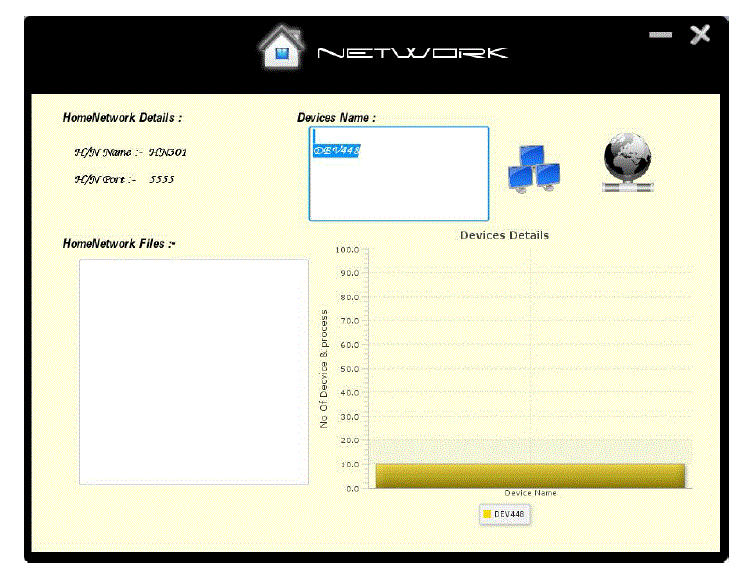 |
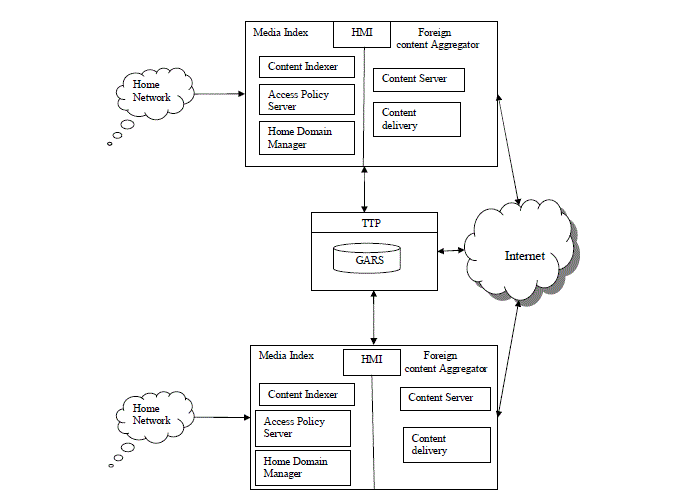 |
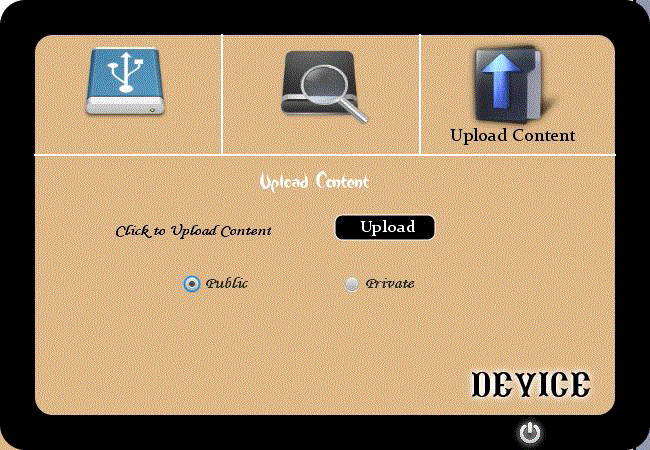 |
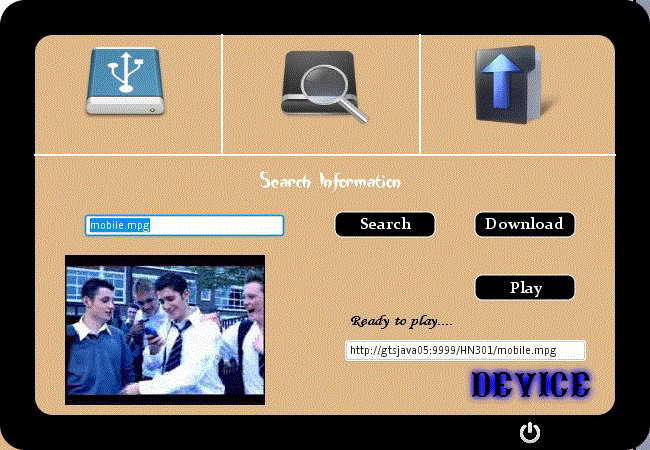 |
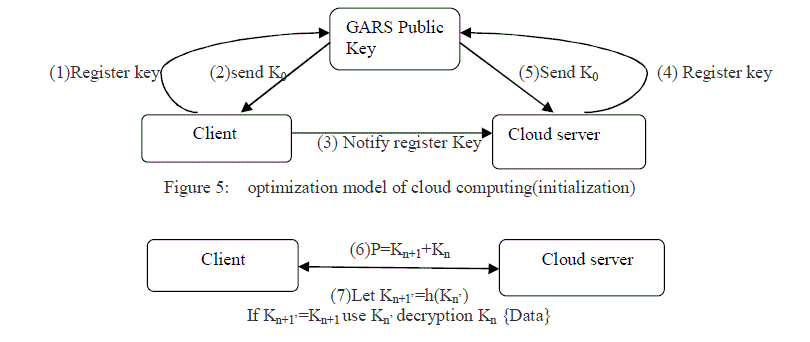 |
| Figure 1 |
Figure 2 |
Figure 3 |
Figure 4 |
Figure 5 |
|
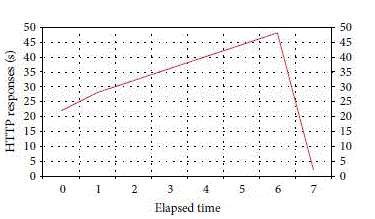 |
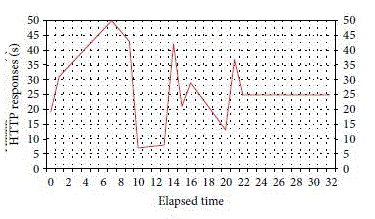 |
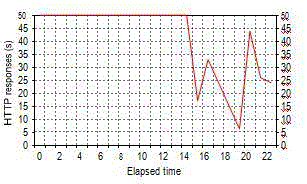 |
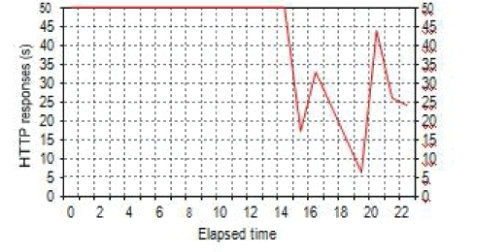 |
| Figure 6 |
Figure 7 |
Figure 8 |
Figure 9 |
|
References |
- Daniel Diaz-Sanchez, FlorinaAlmenarez, Andres Martin, DavideProserpio and Patricia Arias Cabarcos, “Media Cloud:AnOpen Cloud Computing Middleware for Content Management”,IEEE Trans. On Consumer Electronics, Vol 57, No. 2, May2011.
- Mariano Rico, Oscar Corcho, Víctor Méndez and José Manuel Gómez-Pérez, “A Semantically Enhanced UPnP ControlPoint for Sharing Multimedia Content”, IEEE Internet Computing, December 2011.
- Chih-Yung and jih-Fu tu ,“A Novel Cloud Computing Algorithm of Security and Privacy” Hindawi Publishing corporation MathematicalProblems in engineering volume 2013,Aircle ID 871430.
- M. Armbrust, A. Fox, R. Griffith et al., “Above the Clouds: A Berkeley View of Cloud Computing”, 2011.
- L. Gu and S.-C. Cheung, “Constructing and testing privacy-aware services in a cloud computing environment—challenges and opportunities,”in Proceedings of the 1st Asia-Pacific Symposium on Internetware (Internetware ’09), October 2009.
- M. Jensen, J. Schwenk, N. Gruschka, and L. L. Iacono, “On technical security issues in cloud computing,” in Proceedingsof the IEEEInternational Conference on Cloud Computing (CLOUD ’09), pp. 109–116, September 2009.
- M. Mowbray and S. Pearson, “Aclient-based privacy manager for cloud computing,” in Proceedings of the 4th InternationalICSTConference on Communication System Software and Middleware (COMSWARE ’09), Dublin, Ireland, June 2009.
- S. Pearson, “Taking account of privacy when designing cloud computing services,” in Proceedings of the ICSE Workshop on SoftwareEngineering Challenges of Cloud Computing (CLOUD’09), pp. 44–52, Vancouver, Canada, May 2009.
- Kapotas.S.K, Varsaki.E.E, and Skodras.A.N,(2007) “Data Hiding in H- 264 Encoded Video Sequences,” in IEEE 9th Workshop onMultimedia Signal Processing, MMSP.
- Sarkar.A, Madhow.U, Chandrasekaran.S, and Manjunath.B.S,(2007) “Adaptive MPEG-2 Video Data Hiding Scheme,” in Proceedings ofSPIE Security, Steganography, and Watermarking of Multimedia Contents IX.
- Schlauweg.M, Profrock.D, and Muller.E, (2008)“Correction of Insertions and Deletions in Selective Watermarking,” in IEEE International
- Conference on Signal Image Technology and Internet Based Systems, SITIS '08.
- Solanki.K, Jacobsen.N, Madhow.U, Manjunath.B.S, and Chandrasekaran, (Dec. 2004) “Robust image-adaptive data hiding using erasure anderror correction,” IEEE Transactions on Image Processing, vol. 13.
- K. Wong, K. Tanaka, K. Takagi, and Y. Nakajima, (Oct. 2009) “Complete video quality-preserving data hiding,” IEEE Trans. Circuits Syst.Video Technol., vol. 19.
|